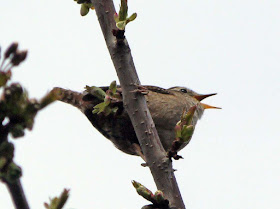Friday, April 21, 2017
Then there were three .....
I didn't really take much notice of the noisy, agitated lapwing overhead, or of the car that drove slowly past until I heard the screech of tyres on tarmac as it braked to a halt. Then I realised there we four little bumps in the road behind it; lapwing chicks that had strayed from the pasture onto the road.
The parent bird, utterly fearless, landed in the road and ushered one of the chicks away into the verge but then took to the air again as the car drove away.
One of the remaining chicks was just a patch of blood and fluffy down on the road but the two others had gone into their instinctive survival routine as we approached, pressing themselves flat against the road and staying perfectly still, hoping they wouldn't be noticed. We picked them up - fluffy, almost weightless bundles with outsized feet - and dropped them over the wall, back into the pasture where they ran for cover - peep-peeping for their parents.
To his credit, the driver turned around and came back to see if he could help and was clearly very distressed that one was dead. In all fairness, if he wasn't forewarned he would have found the birds very hard to see when they were in their defensive prone position in the road.
It was, though, an all-too-common tragedy. The parent birds would have incubated four eggs in their exposed nest for the best part of a month, defending them all day-long against crows, only for one to be flattened under the wheels of a car within hours of hatching.
We really need an awareness-raising campaign in the dales, warning drivers that from now until June they can expect to all sorts of upland juvenile animals and breeding birds straying onto roads, and advising drivers to be vigilant and slow down.
Road traffic takes a terrible toll on wildlife - hares, hedgehogs, badgers, wading bird chicks - in late spring.
Sunday, April 9, 2017
Early spring along the river Wear at Wolsingham, Weardale
Blue skies and warm sunny weather in Weardale this weekend. Here are a few of the sights from a walk along the banks of the river Wear downstream from Wolsingham.
Blackthorn in full bloom everywhere.
Elm flowering is long finished, now the clusters of seeds are developing
Dry weather in the dale, so the water level in the river has dropped rapidly, leaving shallow pools full of trapped fish.
Great tit singing
Grey wagtails are most often seen at the water's edge, but this cock bird was perched in a riverbank tree
A very confiding hedge sparrow. I suspect its was reluctant to fly because its nest was somewhere close, though I failed to find it.
Herb robert coming into flower. This was a nutrient-starved plant rooted in a dead tree and the stress may account for those vivid red leaves
Plenty of ripe ivy berries, particularly valuable food for spring migrants.
Lambs growing fast ..... and very lively
The best find of the day, a morel Morchella esculenta. The sandy silt near the river bank seems to suit these fungi, though they don't appear very often.
Nuthatch, very vociferous at this time of year.
A well-worn peacock butterfly, refuelling on butterbur nectar after a long hibernation
So warm that sheep were looking for somewhere shady to rest by mid-morning
Sycamore buds are exceptionally beautiful when they swell, elongate and begin to burst at this time of year
It was been an exceptional year for toothwort, the parasite that gains all its nutrients from the roots of hazel. Must have seen well over 100 flower spikes.
Click here for more information on this unusual flowering plant that is completely lacking in chlorophyll.
The tiny-flowered ivy-leaved speedwell Veronica hederifolia coming into flower
Willow warblers singing all along the riverbank
Wood sorrel coming into bloom
.... and finally, a very noisy singing wren.























